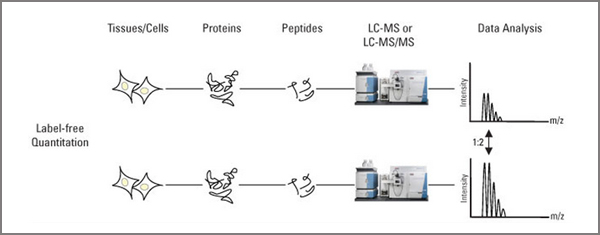
Label-free quantification is a method in mass spectrometry that aims to determine the relative amount of proteins in two or more biological samples. Unlike other methods for protein quantification, label-free quantification does not use a stable isotope containing compound to chemically bind to and thus label the protein.
Label-free quantification may be based on precursor signal intensity or on spectral counting. The computational framework of label free approach includes detecting peptides, matching the corresponding peptides across multiple LC-MS data, selecting discriminatory peptides. The first method is useful when applied to high precision mass spectra, such as those obtained using the new generation of time-of-flight (ToF), fourier transform ion cyclotron resonance (FTICR), or Orbitrap mass analyzers. The high-resolution power facilitates the extraction of peptide signals on the MS1 level and thus uncouples the quantification from the identification process. In contrast, spectral counting simply counts the number of spectra identified for a given peptide in different biological samples and then integrates the results for all measured peptides of the protein(s) that are quantified.
Typically, peptide signals are detected at the MS1 level and distinguished from chemical noise through their characteristic isotopic pattern. These patterns are then tracked across the retention time dimension and used to reconstruct a chromatographic elution profile of the mono-isotopic peptide mass. The total ion current of the peptide signal is then integrated and used as a quantitative measurement of the original peptide concentration. For each detected peptide, all isotopic peaks are first found and the charge state is then assigned.
In contrast to differential labelling, every biological specimen needs to be measured separately in a label-free experiment. The extracted peptide signals are then mapped across few or multiple LC-MS measurements using their coordinates on the mass-to-charge and retention-time dimensions. Data from high mass precision instruments greatly facilitate this process and increase the certainty of matching correct peptide signals across runs.